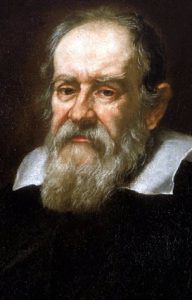
Home - Search - Browse - Alphabetic Index: 0- 1- 2- 3- 4- 5- 6- 7- 8- 9
A- B- C- D- E- F- G- H- I- J- K- L- M- N- O- P- Q- R- S- T- U- V- W- X- Y- Z
Galileo Galilei
 Galileo Credit: NASA |
Born: 1564. Died: 1642-01-01.
Galileo Galilei used the newly invented telescope to view the bodies of the universe and to develop to its most advanced state in the pre-nineteenth century the "Heliocentric System" of the Solar System. Galileo made four important observations that convinced him that Copernican cosmology was correct, as described by writers Lloyd Motz and Jefferson Hane Weaver: "(1) the moon's surface is cratered and highly irregular, thus negating the theory that celestial bodies are 'perfect'; (2) the phases of Venus and those of the moon are similar, proving that Venus revolves around the sun and not around the earth; (3) four moons (satellites) revolve around Jupiter, illustrating in miniature the Copernican model of the solar system; and (4) the Milky Way consists of numerous points of light, which Galileo correctly interpreted as very distant stars" (p. 42). Galileo ran afoul of ecclesiastical authorities because of his observations but they quickly became the standard explanation for understanding the workings of the universe.
Country: Italy. Bibliography: 535, 5415.
1642 January 1 - .
- Death of Galileo Galilei. - . Related Persons: Galileo Galilei. Italian scientist. Used the telescope for astronomy, proving Copernicus heliocentric system. Discovered cratered surface of moon, moons of Jupiter, and that Milky Way was made of stars. By experiment disproved Aristotelian physics concepts..
Back to top of page
Home - Search - Browse - Alphabetic Index: 0- 1- 2- 3- 4- 5- 6- 7- 8- 9
A- B- C- D- E- F- G- H- I- J- K- L- M- N- O- P- Q- R- S- T- U- V- W- X- Y- Z
© 1997-2019 Mark Wade - Contact
© / Conditions for Use